Breaking news
Thales obtains type certification for Spy'Ranger 330 system.
The Spy'Ranger 330 in service with the French Army as part of the SMDR programme has obtained its first type certification by the French defence procurement agency's airworthiness authority, testifying to the system's proven performance in combat situations. Type certification guarantees the airworthiness of the SMDR and enables the Army to use its mini-UAS systems for instruction, training and operational deployments without obtaining specific flight approvals.
Follow Air Recognition on Google News at this link

The SMDR programme has demonstrated the complexity of developing a mini-UAS system for military requirements, in particular in terms of survivability, resistance to cyberattacks and electromagnetic threats, and the ability to operate in harsh environmental conditions (rain, wind, sand, dust, etc.) (Picture source: Thales)
The Spy'Ranger 330 system was designed, developed and put into industrial production for the French defence procurement agency's SMDR programme by an ecosystem of French companies specialising in light unmanned air systems for front-line forces. With three times the range capabilities of its predecessor, the DRAC1 the SMDR system brings the French Army a new, strategically important capability.
The Spy'Ranger 330 mini-UAS and the Spy'Ranger 550 tactical mini-UAS are part of the same family of systems and rely on many of the same building bricks. The Spy'Ranger family is designed to meet the requirements of front-line and reconnaissance units engaged in overseas theatres of operations, offering them a single system that combines a number of key sub-systems to support and provide an image intelligence capability for front-line units: a robust, long-endurance air vehicle designed to operate in difficult environmental conditions, an imaging system to contribute to tactical superiority, a secure datalink and an easy-to-operate command-and-control (C2) system.
The SMDR air vehicle can fly for nearly three hours in a radius of 30 km and the system brings the armed forces access to a number of major technological innovations. Key components of the SMDR system include a multi-sensor (EO and IR) high-definition optronics payload, which is mounted in the Spy'Ball gyrostabilised gimbal and uses high-performance image processing techniques developed for combat aircraft pods such as the Rafale's TALIOS system, the Micro-TMA secure high-speed datalink, and the combat-proven Spy'C command-and-control system. The electrically powered Spy'Ranger 330 air vehicle has an innovative architecture and is made of carbon fibre for low weight and added robustness.
The SMDR programme has demonstrated the complexity of developing a mini-UAS system for military requirements, in particular in terms of survivability, resistance to cyberattacks and electromagnetic threats, and the ability to operate in harsh environmental conditions (rain, wind, sand, dust, etc.).
As programme prime contract, Thales guarantees a high level of safety, security and airworthiness for the SMDR system, which opens a new chapter in the sovereign unmanned flight capabilities of the French forces. Since December 2020, the French Army has operated the SMDR in Mali as part of Operation Barkhane and has been fully satisfied by its performance. Operating in daylight and at night, the SMDR system has contributed to the success of military operations on a routine basis, helping to provide force protection and keep soldiers safe, and consolidating Thales's role as a key player in the French mini-UAS ecosystem.
"Thales and the members of the French mini-UAS ecosystem are trusted partners of the armed forces and the French defence procurement agency on the SMDR programme. To step up to the challenges of the return of high-intensity conflict, Thales is drawing on the innovative potential of this ecosystem, the technical and industrial capabilities it has developed for the SMDR programme, and other strategic partnerships to ensure that France secures its access to these critical technologies." Benoit Plantier, Vice President, Optronics and Missile Electronics, Thales.


























